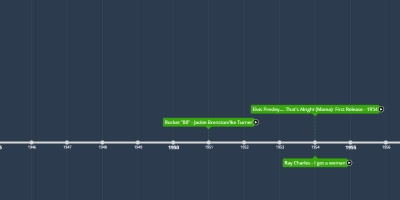jan 2, 1964 - The British Invasion
Description:
By 1964, most American rock fans had all but forgotten the raw backbeat of rockabilly and blues-based rock styles of the fifties. Songs about puppy love sung by teen idols and girl groups accompanied by thickly arranged studio orchestras had dominated the sound of rockmusic for several years. Even rockabilly's originator, Elvis Presley, had long since dropped his rebellious James Dean image and had become a movie star who sang more pop ballads than rock. In November 1963, the American spirit of optimism was crushed by the shocking assassination of President John F. Kennedy. All these factors created a void that made the country's young music fans ready for something new. The sound that captured their attention came from Britain.
Like America, Britain had different musical styles centered in various parts of the country. London was the hub for groups whose music and image were identified with youth subcultures such as the Mods and Rockers (musically, Mods liked "modern" music; Rockers preferred rockabilly and older rock styles), but the city's music fans also supported groups that played American blues and rhythm and blues. The Rolling Stones started out as a rhythm and blues band, but soon found more com mercial success with a style that combined rhythm and blues with other styles of music.
Rock groups from the northern industrial city of Manchester and its seaport neighbor, Liverpool, had a less serious connection with these subcultures and were generally not interested in the blues or rhythm and blues, instead tending toward a simple, folk-based music called skiffie, and later rock music by Buddy Holly. The sound of groups from Liverpool and Manchester was referred to as "Mersey beat," after the name of the river that flows through Liverpool and near Manchester.
Skiffle was a very simple style of folk music that developed out of a combination of African Amer ican folk music, country blues, and early New Orleans jazz. Some of the first skiffle singers to record in Britain had previously been members of jazz bands in the early fifties. One such singer/ banjoist/guitarist was Lonnie Donegan (Anthony Donegan, born in 1931), who became known as Britain's Skiffle King. Donegan even made skiffle records that charted in the U.S. top ten "Rock Island Line" (1956, a cover of a song by Leadbelly) and "Does Your Chewing Gum Lose Its Flavor (On the Bedpost Over Night)?" (released in Britain in 1958 and in the United States in 1961). Skiffle used simple chords that young guitarists could master with little practice and it required little more than the guitar, or sometimes a homemade bass and strumming on a washboard. The simplic ity and rhythmic fun of skiffle made it popular among young people throughout Britain because it allowed every young person to be a musician.
The two primary bands to first invade America were the Beatles and the Rolling Stones. The
Beatles played music influenced by skiffle and Buddy Holly and the Crickets, both of which were popular in the Beatles' hometown of Liverpool. Their image was clean-cut and their personalities displayed an appealing sense of humor. In one early interview after arriving in America they were asked, "How do you find America"? John Lennon quickly replied "Turn left at Greenland." Early in their career, the Beatles wore matching suits that were distinctively tailored, often with colored trim instead of lapels. They wore heeled boots that soon became popular, called "Beatie boots." At the time, most American rock groups dressed alike, but the Beatles' styling looked English. Their hair was long by American standards, but still clean and neat.
The Rolling Stones, on the other hand, gave up on the idea of wearing matching outfits and wore much more casual clothing on stage than was standard for the time. Their image was deliberately cultivated as the "nasty" opposite of the Beatles and they played rhythm and blues much more like the music of Bo Diddley than Buddy Holly. As Mick Jagger said in a 1964 interview; "If people don't like us, well that's too bad. We're not thinking of changing, thanks very much. We've been the way we are for much too long to think of kow-towing to fanciful folk who think we should start tarting ourselves up with mohair suits and short haircuts." In real life, members of the Beatles and the Rolling Stones became friends with one another and they shared much the same "rock star" lifestyle. In fact, the Rolling Stones' second hit record was "I Wanna Be Your Man," which John Lennon and Paul McCartney gave them to record. On the B side of the single, however, was an other song that was true to the image the Rolling Stones were creating for themselves and very much unlike anything that the Beatles would have recorded in 1964. "Stoned" was a twelve-bar blues that was mostly instrumental with Jagger uttering intoxicated vocal comments at the end of each chorus.
Added to timeline:
Date:
jan 2, 1964
Now
~ 60 years ago

